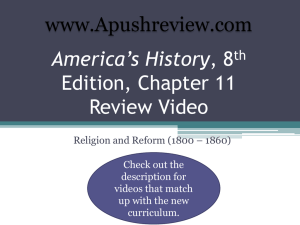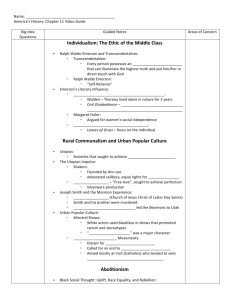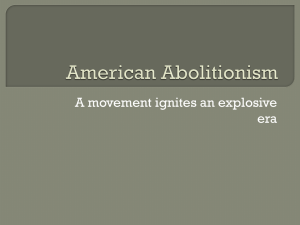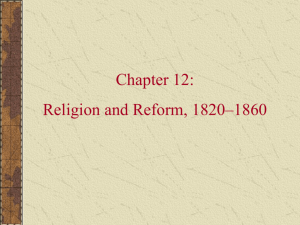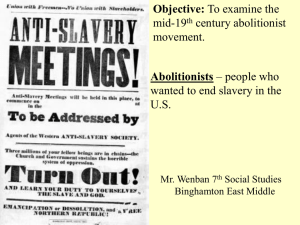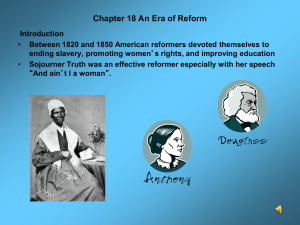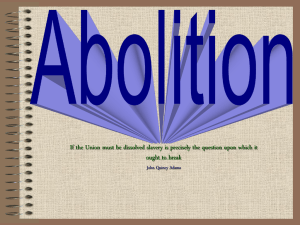Chapter 11 - School Webmasters
advertisement
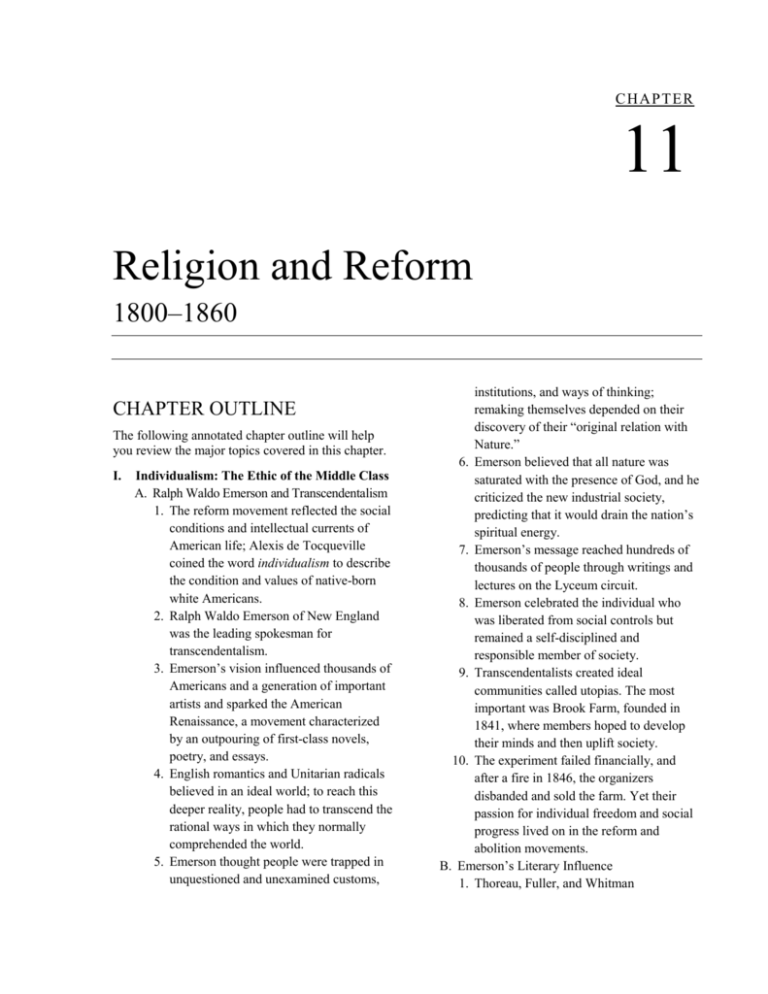
C HAP TER 11 Religion and Reform 1800–1860 CHAPTER OUTLINE The following annotated chapter outline will help you review the major topics covered in this chapter. I. Individualism: The Ethic of the Middle Class A. Ralph Waldo Emerson and Transcendentalism 1. The reform movement reflected the social conditions and intellectual currents of American life; Alexis de Tocqueville coined the word individualism to describe the condition and values of native-born white Americans. 2. Ralph Waldo Emerson of New England was the leading spokesman for transcendentalism. 3. Emerson’s vision influenced thousands of Americans and a generation of important artists and sparked the American Renaissance, a movement characterized by an outpouring of first-class novels, poetry, and essays. 4. English romantics and Unitarian radicals believed in an ideal world; to reach this deeper reality, people had to transcend the rational ways in which they normally comprehended the world. 5. Emerson thought people were trapped in unquestioned and unexamined customs, institutions, and ways of thinking; remaking themselves depended on their discovery of their “original relation with Nature.” 6. Emerson believed that all nature was saturated with the presence of God, and he criticized the new industrial society, predicting that it would drain the nation’s spiritual energy. 7. Emerson’s message reached hundreds of thousands of people through writings and lectures on the Lyceum circuit. 8. Emerson celebrated the individual who was liberated from social controls but remained a self-disciplined and responsible member of society. 9. Transcendentalists created ideal communities called utopias. The most important was Brook Farm, founded in 1841, where members hoped to develop their minds and then uplift society. 10. The experiment failed financially, and after a fire in 1846, the organizers disbanded and sold the farm. Yet their passion for individual freedom and social progress lived on in the reform and abolition movements. B. Emerson’s Literary Influence 1. Thoreau, Fuller, and Whitman C HAPTER 11 • R ELIGION AND R EFORM a. Emerson urged American writers to celebrate democracy and individual freedom and to find inspiration in the familiar. b. Henry David Thoreau heeded Emerson’s call and turned to nature for inspiration. In 1854, he published Walden, or Life in the Woods. c. Thoreau became an advocate for social nonconformity and civil disobedience against unjust laws, both of which he practiced. d. Margaret Fuller, also a writer, began a transcendental discussion group for elite Boston women and published Woman in the Nineteenth Century, which proclaimed that a “new era” was coming in the relations between men and women. e. Fuller believed that women, like men, had a mystical relationship with God and that every woman deserved psychological and social independence. f. In 1855, Walt Whitman—a teacher, journalist, and publicist for the Democratic Party—published the first edition of Leaves of Grass, which recorded his attempts to pass a number of “invisible boundaries.” g. Whitman did not seek isolation but rather perfect communion with others; he celebrated democracy as well as himself, arguing that a poet could claim a profoundly intimate, mystical relationship with a mass audience. 2. Darker Visions a. Although transcendentalists were in general optimistic, several also expressed pessimistic worldviews. Nathaniel Hawthorne warned in The Scarlet Letter (1850) that excessive individualism could result in a profound sense of guilt and society’s condemnation. b. Herman Melville asserts in Moby Dick (1851) that individuals who lack discipline and responsibility will not achieve transcendence but death. c. Of all of these writers, American readers preferred the more modest examples of individualism offered by Emerson, who made personal improvement through spiritual awareness and self-discipline seem possible. II. Rural Communalism and Urban Popular Culture A. The Utopian Impulse 1. Mother Ann and the Shakers a. In rural Northeastern and Midwestern states, communalists established utopias as protests to social conformity and economic change. b. Led by “Mother” Ann Lee Stanley, the Shakers were the first successful American communal movement. c. The Shakers accepted the common ownership of property and a strict government by the church and pledged to abstain from alcohol, tobacco, politics, and war. d. Shakers believed that God was both male and female, but they eliminated marriage and were committed to a life of celibacy. e. Beginning in 1787, the Shakers founded twenty communities, mostly in New England, New York, and Ohio. f. Their agriculture and crafts, particularly furniture making, enabled most of the communities to become self-sustaining and even comfortable. g. Shaker communities attracted more than three thousand converts during the 1830s and they welcomed blacks as well as whites. h. Because Shakers had no children of their own, they relied on conversion or adoption of orphans to replenish their numbers. i. The Shakers had virtually disappeared by the end of the nineteenth century. C HAPTER 11 • R ELIGION AND R EFORM 2. Albert Brisbane and Fourierism a. Charles Fourier, a French utopian reformer, devised an eight-stage theory of social evolution and predicted the decline of individualism and capitalism. b. Albert Brisbane, Fourier’s disciple, believed that cooperative work groups called phalanxes would replace capitalist wage labor with socialism and liberate both men and women. c. Brisbane skillfully promoted Fourier’s ideas in his influential book The Social Destiny of Man (1840), through a regular column in the New York Tribune, and via hundreds of lectures. d. In the 1840s, Brisbane and his followers started nearly 100 cooperative communities, but they quickly collapsed because of internal disputes over work responsibilities and social policies. 3. John Humphrey Noyes and Oneida a. The minister John Humphrey Noyes set about creating a community that defined sexuality and gender roles in radically new ways. b. Noyes, who was inspired by the preaching of Charles Finney, was expelled from his Congregational church and became a leader of perfectionism. c. Perfectionists believed that the Second Coming of Christ had already occurred and that people could therefore aspire to perfection in their earthly lives. d. Noyes and his followers embraced complex marriage—all the members of the community being married to one another. e. Noyes sought to free women from being regarded as their husbands’ property and to free them from endless childbearing and childrearing. f. Opposition to complex marriage in Noyes’s hometown of Putney, Vermont, prompted him to move to Oneida, New York, in the mid-1840s. g. The Oneida community became financially self-sufficient when one of its members invented a steel animal trap, and others turned to silver manufacturing; the silver-making business survived into the twentieth century. h. The historical significance of the Shakers, the Fourierists, and Noyes and his followers is that they attempted to live their lives in what they conceived of as a more egalitarian social order and left their countercultural blueprints to posterity. B. Joseph Smith and the Mormon Experience 1. Joseph Smith a. In contrast to the Shakers and the Oneidians, the Mormons aroused more hostility because they were more cohesive and successfully attracted thousands of members. b. Mormonism emerged from the religious fervor in New England during the Second Great Awakening. c. Founder Joseph Smith believed God had singled him out to receive a special revelation of divine truth—The Book of Mormon. d. Smith organized the Church of Jesus Christ of Latter-day Saints; affirmed traditional patriarchal authority; encouraged hard work, saving of earnings, and entrepreneurship; and started a church-directed community intended to inspire moral perfection. e. The Mormons eventually settled in Nauvoo, Illinois, and became the largest utopian community in America. f. Resentment toward the Mormons turned to overt hostility when Smith refused to abide by some Illinois laws, asked that Nauvoo be turned into a separate federal territory, and then C HAPTER 11 • R ELIGION AND R EFORM declared himself a candidate for president. g. Smith believed in polygamy—having more than one wife at a time. h. In 1844, Smith was murdered in jail after being arrested for trying to create a Mormon colony in Mexico. 2. Brigham Young and Utah a. Led by Brigham Young, the Mormons settled in the Great Salt Lake Valley and spread planned agricultural communities across present-day Utah (then part of Mexico). b. Mormons who did not support polygamy remained in the United States; led by Smith’s son, they formed the Reorganized Church of Jesus Christ of Latter-day Saints. c. Congress established the Utah Territory in 1850 and named Brigham Young its governor. Young and the territorial legislature resisted federal law to maintain autonomy of the church. d. Although President James Buchanan was afraid that if he tried to eliminate polygamy it might set a precedent that could be used to end slavery, he sent a small army to Utah contributing to the short-lived “Mormon War.” e. Mormons in Utah and the Midwest succeeded because they reinvigorated the patriarchal family, endorsed private ownership of property, and accepted the entrepreneurial spirit of a market economy. C. Urban Popular Culture 1. Sex in the City a. As utopian reformers organized new communities on the land, rural migrants and foreign immigrants created a new culture in the cities. b. Between 1800 and 1840, America experienced a high rate of urban growth. By 1860, New York numbered over 1 million residents. c. Urban growth generated a new urban culture as young men and women adjusted to a life of hard work. d. Young working-class laborers, domestic servants, and factory operatives engaged in commercialized sex and serial monogamy while dressing in the latest fashion style, such as the “B’hoy” and the “Bowery Gal.” 2. Minstrelsy a. Popular entertainment was another facet of the new urban culture, particularly in New York. Blood sports, performances of Shakespeare, and museums run by P. T. Barnum were popular attractions. b. The most important form of entertainment was blackface minstrelsy, a complex blend of racist caricature and social criticism in which white men masqueraded as African Americans. c. The shows reinforced white supremacy, nativism, and class criticism of elite control of industry and politics. 3. Immigrant Masses and Nativist Reaction a. A growing number of Irish and German immigrants settled in northeastern cities like New York, and their cultural traits became part of urban society. b. Many urban New Yorkers and northeasterners disdained these immigrants, particularly the Irish, and beginning in the 1830s created a violent and political nativist movement in an attempt to halt their arrival. c. Inspired by temperance, antiCatholicism, and nativism, urban organizations such as the Female Moral Reform Society and Washington Temperance Society aimed to reform a society in turmoil. III. Abolitionism C HAPTER 11 • R ELIGION AND R EFORM A. Black Social Thought: Uplift, Race Equality, and Rebellion 1. David Walker’s Appeal a. Inspired by the Second Great Awakening, abolitionists increasingly defined slavery as a sin and demanded its immediate termination. b. Leading African Americans in the North advocated policies of social uplift; they encouraged free blacks to “elevate” themselves through education, temperance, moral discipline, and hard work and, by securing “respectability,” to assume a position of equality with the white citizenry. c. Some whites felt threatened by this and in the mid-1820s led mob attacks against blacks. d. In 1829, David Walker’s An Appeal … to the Colored Citizens of the World justified slave rebellion, warning of a slave revolt if their freedom was delayed. e. In 1830, African American activists called a national convention in Philadelphia. The delegates did not endorse Walker’s radical call for revolt but made collective equality for all blacks their fundamental demand. This new generation of African American leaders focused on “race-equality” rather than individual uplift and respectability. 2. Nat Turner’s Revolt a. As Walker called for a violent black rebellion in Boston, Nat Turner staged a bloody revolt in Southampton County, Virginia. b. Turner, a slave, believed that he was chosen to carry Christ’s burden of suffering in a race war. c. Turner’s men killed nearly sixty whites in 1831; he hoped other slaves would rally to his cause, but few did, and they were dispersed by a white militia. d. Vengeful whites began to take the lives of blacks at random, and Turner was captured and hanged. e. Shaken by Turner’s Rebellion, the Virginia legislature debated a bill for emancipation and colonization, but the bill was rejected and the possibility that southern planters would legislate an end to slavery faded. f. Southern states toughened their slave codes and prohibited anyone from teaching a slave to read. B. Evangelical Abolitionism 1. William Lloyd Garrison, Theodore Weld, and Angelina and Sarah Grimké a. A dedicated cadre of northern and Midwestern evangelical whites launched a moral crusade to abolish slavery. b. William Lloyd Garrison, an abolitionist leader, founded The Liberator in 1831 and spearheaded the formation of the New England AntiSlavery Society. c. Garrison condemned the American Colonization Society, attacked the U.S. Constitution for its implicit acceptance of racial bondage, and demanded the immediate abolition of slavery. d. In 1833, Garrison, Theodore Weld, and Arthur and Lewis Tappan, along with other delegated, established the American Anti-Slavery Society. Women joined the movement and founded the Philadelphia Female AntiSlavery Society and the Anti-Slavery Conventions of American Women. e. In 1837, Weld’s publication, The Bible Against Slavery, cited passages from Christianity’s holiest book to discredit slavery. f. Weld and Angelina and Sarah Grimké provided the abolitionist movement with a mass of evidence in American Slavery as It Is: Testimony of a Thousand Witnesses (1839), which C HAPTER 11 • R ELIGION AND R EFORM depicted the actual condition of slavery in the United States. 2. The American Anti-Slavery Society a. The development of the steampowered press allowed the AntiSlavery Society to use mass communication to sway public opinion. b. The abolitionist leaders also assisted blacks who fled from slavery via the Underground Railroad. c. Abolitionists limited the effectiveness of the Fugitive Slave Law by attacking slave catchers, setting captives free, and taking run-away slaves to Canada. d. Members of the Anti-Slavery Society flooded Congress with petitions demanding abolition of slavery in the District of Columbia, an end to the interstate slave trade, and a ban on admitting any new slave states. e. Thousands of men and women were drawn to the abolitionist movement, including Ralph Waldo Emerson and Henry David Thoreau. C. Opposition and Internal Conflict 1. Attacks on Abolitionism a. The abolitionist crusade won the wholehearted allegiance of only a small minority of Americans. b. Americans feared that abolitionist agitation would contribute to sectional rift, destruction of property rights, empowerment of women, declining wages, increased competition for jobs, loss of profits, and, most importantly, racial mixing. c. Northern opponents of abolitionism often turned to violence and thus demonstrated the extent of racial prejudice and heightened race consciousness in that region. d. Southern whites reacted to abolitionists with fury, offering a reward for Garrison’s kidnapping and destroying abolitionist literature. e. In 1835, Andrew Jackson asked Congress to restrict the use of the mails by abolitionist groups; Congress did not comply, but the House adopted the notorious gag rule that automatically tabled any legislation about slavery. 2. Internal Divisions a. Abolitionists were divided among themselves over issues of gender; Garrison not only broadened his reform agenda to include pacifism and the abolition of prisons, but also to women’s rights when he demanded that the society “emancipate” women from their servile positions and make them equal with men. b. Garrison’s opponents founded the American and Foreign Anti-Slavery Society. c. Some abolitionists turned to politics, establishing the Liberty Party and nominating James G. Birney for president in 1840; he won few votes. d. The very strength of abolitionism proved to be its undoing because its radical program aroused the hostility of a substantial majority of the white population. IV. The Women’s Rights Movement A. Origins of the Women’s Movement 1. Moral Reform a. During the American Revolution, the belief arose that women should limit their political role to that of “republican mothers” who would instruct “their sons in the principles of liberty and government.” A woman should inhabit a “separate sphere” made up of her home and members of her family. b. Many middle-class women transcended these rigid boundaries by joining in the Second Great Awakening, through which they gained authority and influence over many areas of family C HAPTER 11 • R ELIGION AND R EFORM life, including the timing of pregnancies. c. Some women used their newfound religious authority to increase their involvement outside the home, beginning with moral reform. d. The Female Moral Reform Society, founded in 1834 and led by Lydia Finney, had as its goals ending prostitution, redeeming fallen women, and protecting single women from moral corruption. 2. Improving Prisons, Creating Asylums, Expanding Education a. Dorothea Dix served as a vanguard in women’s efforts to reform social institutions by setting up schools for disadvantaged children. b. Dix’s discovery that insane women lingered in prisons alongside male criminals inspired her to campaign for the establishment of state asylums and public hospitals. c. Northern women supported the movement led by Horace Mann to increase the number of public elementary schools and improve their quality. d. Catharine Beecher, the intellectual leader of a new corps of women teachers, argued that women were the best qualified to instruct the young. e. By the 1850s, most teachers were women, in part because of Beecher’s arguments but also because women could be paid less than men. B. From Black Rights to Women’s Rights 1. Abolitionist Women a. Women were crucial participants in the antislavery movement because they understood the sexual abuse female slaves experienced during their life time. Harriet Jacobs’s Incidents in the Life of a Slave Girl and Harriet Beecher Stowe’s Uncle Tom’s Cabin graphically described the horrors of slavery for women. b. Maria W. Stewart, a Garrisonian abolitionist and an African American, lectured to mixed audiences in the early 1830s; white women also began to deliver abolitionist lectures. c. A few women began to challenge the subordinate status of their sex; the most famous were Angelina and Sarah Grimké, who used Christian and Enlightenment principles to claim equal civic rights for women. d. By 1840, female abolitionists were asserting that traditional gender roles amounted to the “domestic slavery” of women. e. Drawn into public life by abolitionism, thousands of northern women had become firm advocates of greater rights not only for enslaved African Americans but also for themselves. 2. Seneca Falls and Beyond a. During the 1840s, women’s rights activists, often with support from affluent men, tried to strengthen the legal rights of married women; three states enacted married women’s property laws between 1839 and 1845, and an 1848 New York statute gave a woman full legal control over the property she brought to a marriage, which became the model for similar laws in fourteen other states. b. Elizabeth Cady Stanton and Lucretia Mott organized a gathering in Seneca Falls, New York, that outlined a coherent statement of women’s equality. c. The Seneca Falls activists relied on the Declaration of Independence and repudiated the idea that the assignment of separate spheres for men and women was the natural order of society. C HAPTER 11 • R ELIGION AND R EFORM d. Although most men and many women rejected the activists and their message, in 1850, the first national women’s rights convention began to hammer out a reform program and began a concerted campaign for more legal rights and to win the vote for women. e. Susan B. Anthony joined the women’s rights movement and created a network of female political “captains” who lobbied state legislatures for women’s rights. f. In 1860, New York granted women the right to collect and spend their own wages, to bring suit in court, to control property, and to serve as guardians of their children in the event they became widows.
